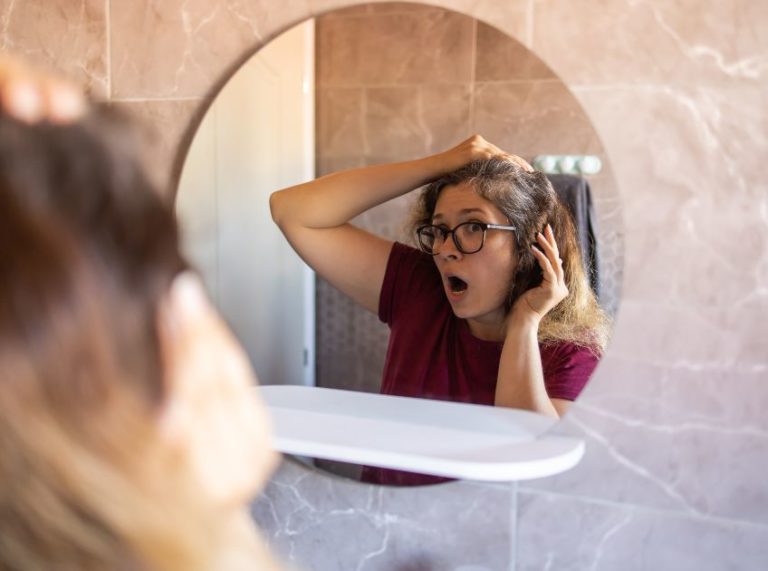
Important: This article is for informational purposes only. Please read our full disclaimer for more details.
Dyeing hair is not just a beauty routine; it’s also an art form that evolves with time. One such evolution in hair dyeing techniques is dying wet hair. Traditionally, hair dyeing has been done on dry hair, but the method of dyeing wet hair offers unique advantages and stunning results.
This article will explore the process, benefits, tips, and help you know if you can dye wet hair.
When dyeing hair, applying color to wet strands is a technique that can give hair the desired color. By dyeing wet hair instead of dry hair, the color is better absorbed into the hair shaft.
Besides, other benefits that you can get while dyeing wet hair include the following-
- Reduces damage
- Improves color blending
- Ensures better moisture retention
Overall, dyeing wet hair is a highly effective way to achieve great color results while minimizing the potential for damage.
So, the answer to can you dye wet hair is yes; however, it comes with a few downsides too such as color may not be as vibrant as when used on dry hair.
It is not uncommon for professional stylists to use color on damp hair, mainly when toning the hair, to prevent over-depositing when lighter shades are desired.
How to Dye Hair While Wet?

If you plan to dye your hair at home, doing it in the shower can help you manage the mess. Applying the dye to wet hair is usually recommended by most at-home dyes.
Here are some general steps to dyeing wet hair:
1. Rinse your hair with lukewarm water, but avoid shampooing it.
2. Make sure your hair is damp, not soaking wet. If it’s too wet, the hair color will slide right off. Squeeze the excess water out of your hair with a towel to prevent it from dripping.
3. Apply semi or demi-permanent hair dye to the area you want to cover.
4. Cover your head with a shower cap and wait for about 20 minutes or as per the instructions on the dye package.
5. Rinse the dye out.
Check the instructions on your hair dye package, as some products may have additional steps.
What Are the Disadvantages (1) of Dyeing Your Hair While It’s Wet?

Your hair stylist will typically color your hair while it’s dry. Coloring dry hair helps the stylist better manage the result. On the other hand, coloring wet hair can hinder the color from entirely depositing or lifting, which can affect the durability and lifespan of the color.
Hair dye is designed to soak into the hair cuticles, not just rest on the surface of the hair strands. It can only be absorbed entirely into the hair cuticles when dry. If you prefer a more subtle color, there are better ideas than coloring your hair while wet.
Below are the downsides of dyeing wet hair-
1. Uneven Hair Color
When applying hair dye, the moisture present in wet hair can cause the color to spread unevenly, concentrating in some areas while sliding off others. This can result in an uneven look.
2. Diluted Hair Color
Wet hair absorbs water that can dilute the hair dye and prevent it from adequately penetrating the cuticles. It is one of the reasons why professional hair stylists prefer to color hair when dry, especially if it is already dry or damaged.
Instead, the color may appear more subtle and sit on top of your hair rather than wholly absorbing. Sometimes, the color may not absorb at all and will wash off with the first shampoo.
3. It Is Not as Effective for Permanent Hair Coloring
It may not work when it comes to permanent hair color. This is because the color sits more on top of hair strands than it absorbs, causing it to fade or wash out quicker and requiring more frequent touch-ups.
4. Prone to Damage
Additionally, applying color treatment to wet hair can be more damaging to the strands. Damp hair is more fragile because the cuticles open when wet, making it more susceptible to damage. At the same time, when the hair is dry, they have natural oils that can provide protection to the strands to some extent from the chemicals present in the dye.
Conclusion
Even though it is possible to dye your hair while wet, remember that the color may not be as vibrant and may not last as long as it would if you did it while it was dry. Additionally, the color may appear more uneven.
Hair dyes contain chemicals to bring color to the hair. Since applying any type of dye can reduce hair quality due to these chemicals, you need to be extra gentle while using them. Color hair as per the instructions written on the label to achieve the best results and keep the hair safe.
Related Articles
- Can You Bleach Your Hair When It’s Wet?
- Will My Hair Dye Run In A Swimming Pool?
- How To Remove Hair Dye Stain From Sink
- How Often Can You Bleach Your Hair?
- How To Tone Down Pink Hair
- How to Keep Your Hair Healthy in Summer
- How to Use Coconut oil for Dry Hair Treatment?
- How to Safely Bleach Your Hair with Hydrogen Peroxide?
Image Source : canva















